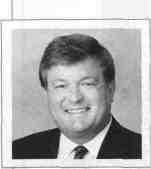ACROSS THE BOARD 
Following the Board Meeting Agenda by Dr. Ted Flickinger, CLP IAPD Executive Director Good board meetings are well planned. They are purposeful, businesslike, informative, challenging and relatively short. The board should not meet to approve the minutes and waste the hours.
SETTING THE AGENDA
FOLLOWING THE AGENDA The board must set rules for public participation. Make board meetings public meetings, but not meetings of the public. A citizen should express a concern or give a report within a reasonable time (generally three to five minutes). The board should agree to a time on the agenda for citizen participation, and a period of time for each speaker, so all who want to participate are given a chance. To keep meetings from becoming too long, I have heard of some boards implementing a policy that imposes a 9:00 p.m. meeting curfew (for meetings beginning at 7:00 p.m. or 7:30 p.m.). To go beyond that time period, board members must vote to extend the deadline. 1. Call the Meeting on Time. People's time is valuable. At the designated time and when a quorum is reached, the board president (chair) will call the meeting to order. Calling the meeting to order on time demonstrates the professionalism and businesslike manner in which meetings will be conducted. When the gavel falls, socializing should end and business begins. 2. Attendance. The minutes should reflect who is present and absent. Many boards record in the minutes who arrived late and the time of their arrival. This encourages on-time attendance and legally points out who voted on what issues. It's somewhat demeaning, but often practiced for the above reasons. 3. Recognize Visitors. Introduce invited guests such as staff, vendors or other visitors. The minutes should reflect guests who speak. Boards often require guests to sign a special visitors form. This is done to shorten the time for introductions and sometimes as a security measure. 6 * Illinois Parks & Recreation * May/June 1996 4. Approve the Agenda. As previously indicated, board members may request adding items to the agenda. However, last-minute requests should be discouraged. This not only extends the meeting but often the chief executive or board members will not have sufficient time to gather enough information about an issue. 5. Approve Minutes. Meeting minutes are extremely important. They are the official records of board actions. Therefore, each board member should scrutinize the minutes and correct any errors before the full board votes on approval. 6. Chief Executive's Report. The chief executive's report generally should be for informational purposes. Any issues requiring action should be placed on the agenda under new business. The chief executive should mail an informational packet with the agenda that includes a progress report. The director's report should identify current issues, pertinent correspondence, statistics on services and operations, staff activities (including honors, awards, promotions and continuing education, etc.). In addition, it is recommended that the chief executive develop pro and con position statements on issues that will be addressed by the board under new business. The board needs to know the alternatives that are available in their decision-making process. 7. Financial Report Some boards request that the chief executive include the financial report at the beginning of the meeting or immediately following his or her report. The financial report could affect the actions of the board on other agenda items. The information sent by the chief executive prior to the meeting should contain charts or spreadsheets and the payment of bills. The board should approve the payment of bills. Questions about bills should have been directed to the chief executive prior to the board meeting unless the item is a question for the entire board. The financial report should not involve in-depth discussions or debates on ways to find new revenues or what to do with surplus funds. These issues should be placed on the agenda under new business. 8. Committee or Task Force Reports. Again, written reports should be sent to board members in sufficient time for review prior to board meetings. Therefore, the board should only hear from committees or task forces that have recommendations for board actions. 9. Unfinished Business. This includes such items as tabled motions, items not addressed due to adjournment or those intentionally carried over for more research or discussion. A building project is not always unfinished business! Any action the board needs to take should probably be under new business. 10. New Business. Some new business requires routine action. Others call for debate. The chief executive must prepare, in cooperation with individual board members or committee or task force members, the various sides of an issue with prioritized resolutions. Most boards require each member to vote on a motion. Consensus decisions don't record how each board member voted. Of course, some issues will call for special closed meetings such as evaluation of chief executive and purchasing land or buildings. 11. Announcements. Future meetings, events and "for your information." 12. Adjournment. The board needs a motion approved to adjourn when agenda items still remain. Otherwise, the president of the board can simply declare the meeting adjourned. IN THE NEXT ISSUE "Evaluating the Effectiveness of Board Meetings" Illinois Parks & Recreation * May/June 1996 * 7 |
||||||||||||||
